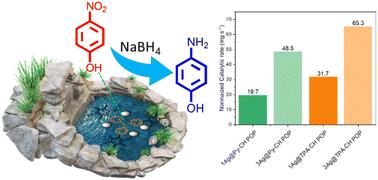当前位置:
X-MOL 学术
›
Polym. Chem.
›
论文详情
Our official English website, www.x-mol.net, welcomes your
feedback! (Note: you will need to create a separate account there.)
Rational decoration of porous organic polymers with silver nanoparticles for strategic reduction of hazardous nitroaryl compounds
Polymer Chemistry ( IF 4.1 ) Pub Date : 2024-11-14 , DOI: 10.1039/d4py01179a Mohammed G. Kotp, Ahmed F. M. EL-Mahdy, Shiao-Wei Kuo
Polymer Chemistry ( IF 4.1 ) Pub Date : 2024-11-14 , DOI: 10.1039/d4py01179a Mohammed G. Kotp, Ahmed F. M. EL-Mahdy, Shiao-Wei Kuo

|
Porous organic polymers (POPs) have garnered significant attention across various industries due to their promising physicochemical properties. In this study, we employ the classical Friedel–Crafts alkylation strategy to synthesize two types of porous organic polymers, namely Py–CH POP and TPA–CH POP, utilizing chloranil (CH), pyrene (Py), and triphenylamine (TPA) as building blocks. The Py–CH POP exhibits coaxial-like morphologies, uniform micropores, and a moderate surface area of up to 822 m2 g−1, along with excellent thermal stability, recording a char output of 69.6 wt%. Notably, these CH POPs contain dynamic hydroxyl groups that can effectively attract Ag+ ions from silver nitrate solutions and facilitate their reduction into silver nanoparticles, resulting in the formation of Ag@Py–CH and Ag@TPA–CH POP nanocomposites. These nanocomposites serve as efficient nano-catalysts for the reduction of hazardous p-nitrophenol (p-NP) to the safer p-aminophenol (p-AP) at ambient temperature. Importantly, the Ag@Py–CH and Ag@TPA–CH POP nanocomposites demonstrate comparable normalized reduction rates of p-NP, reaching up to 65.3 mg s−1. The quaternary amine sites in the Ag@TPA–CH POP nanocomposites play a crucial role in this catalytic reaction, enhancing interactions with the phenolic hydroxyl groups of p-NP and thereby accelerating the reduction process compared to Ag@Py–CH POP. This strategy presents a dynamic approach for the reduction of p-NP, leading to the clean production of p-AP.
中文翻译:

用纳米银颗粒合理装饰多孔有机聚合物,以战略性地减少有害的硝基芳基化合物
多孔有机聚合物 (POP) 因其有前途的物理化学特性而在各个行业引起了广泛关注。在这项研究中,我们采用经典的 Friedel-Crafts 烷基化策略合成两种类型的多孔有机聚合物,即 Py-CH POP 和 TPA-CH POP,利用氯苯胺 (CH)、芘 (Py) 和三苯胺 (TPA) 作为构建单元。Py-CH POP 表现出同轴状形态、均匀的微孔和高达 822 m2 g-1 的中等表面积,以及出色的热稳定性,记录的焦化输出为 69.6 wt%。值得注意的是,这些 CH POP 含有动态羟基,可以有效地吸引硝酸银溶液中的 Ag+ 离子并促进它们还原成银纳米颗粒,从而形成 Ag@Py-CH 和 Ag@TPA-CH POP 纳米复合材料。这些纳米复合材料可作为高效的纳米催化剂,在环境温度下将有害的对硝基苯酚 (p-NP) 还原为更安全的对氨基苯酚 (p-AP)。重要的是,Ag@Py-CH 和 Ag@TPA-CH POP 纳米复合材料表现出相当的 p-NP 归一化还原率,最高可达 65.3 mg s-1。Ag@TPA-CH POP 纳米复合材料中的季胺位点在该催化反应中起着至关重要的作用,与 Ag@Py-CH POP 相比,增强了与 p-NP 的酚羟基的相互作用,从而加速了还原过程。该策略提出了一种减少 p-NP 的动态方法,从而实现 p-AP 的清洁生产。
更新日期:2024-11-19
中文翻译:

用纳米银颗粒合理装饰多孔有机聚合物,以战略性地减少有害的硝基芳基化合物
多孔有机聚合物 (POP) 因其有前途的物理化学特性而在各个行业引起了广泛关注。在这项研究中,我们采用经典的 Friedel-Crafts 烷基化策略合成两种类型的多孔有机聚合物,即 Py-CH POP 和 TPA-CH POP,利用氯苯胺 (CH)、芘 (Py) 和三苯胺 (TPA) 作为构建单元。Py-CH POP 表现出同轴状形态、均匀的微孔和高达 822 m2 g-1 的中等表面积,以及出色的热稳定性,记录的焦化输出为 69.6 wt%。值得注意的是,这些 CH POP 含有动态羟基,可以有效地吸引硝酸银溶液中的 Ag+ 离子并促进它们还原成银纳米颗粒,从而形成 Ag@Py-CH 和 Ag@TPA-CH POP 纳米复合材料。这些纳米复合材料可作为高效的纳米催化剂,在环境温度下将有害的对硝基苯酚 (p-NP) 还原为更安全的对氨基苯酚 (p-AP)。重要的是,Ag@Py-CH 和 Ag@TPA-CH POP 纳米复合材料表现出相当的 p-NP 归一化还原率,最高可达 65.3 mg s-1。Ag@TPA-CH POP 纳米复合材料中的季胺位点在该催化反应中起着至关重要的作用,与 Ag@Py-CH POP 相比,增强了与 p-NP 的酚羟基的相互作用,从而加速了还原过程。该策略提出了一种减少 p-NP 的动态方法,从而实现 p-AP 的清洁生产。


















































 京公网安备 11010802027423号
京公网安备 11010802027423号